For many years Logan Square residents have been pushing for the city of Chicago to fix the traffic circle in the center of the neighborhood that's a safety hazard for all road users and a barrier to walking and biking across the neighborhood. Now that dream is close to fruition.
At a community meeting last night at Logandale Middle School, Chicago Department of Transportation staffers presented the agency's final recommendations for redesigning the circle at Logan Boulevard, Kedzie Avenue, and Milwaukee Avenue, as well as the Milwaukee corridor between Logan and Belmont Avenue. While the department presented four different design concepts that had been considered, officials are recommending a bold reconfiguration of the historic square that would also return the space to its roots as a safe, people-friendly gathering spot.
The first concept, dubbed "Spot Improvements," would essentially maintain the status quo with a few minor changes, including new bike lanes and curb extensions
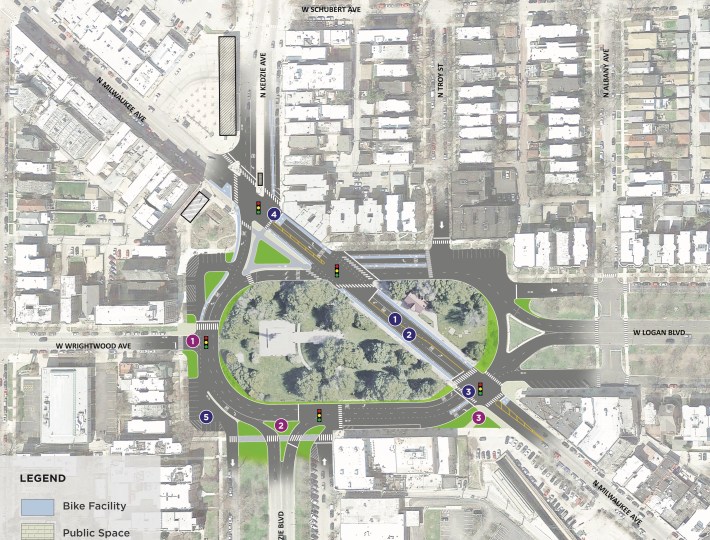
The second scenario, called "Traffic Oval," would realign Kedzie by the Logan Square Blue Line station to create a new plaza, and pedestrianize the segment of Milwaukee that divides the two portions of the green space within the traffic circle, which contains the eagle-topped Illinois Centennial Monument pillar. However, as with Spot Improvements, one-way, counter-clockwise traffic around the circle would be maintained.
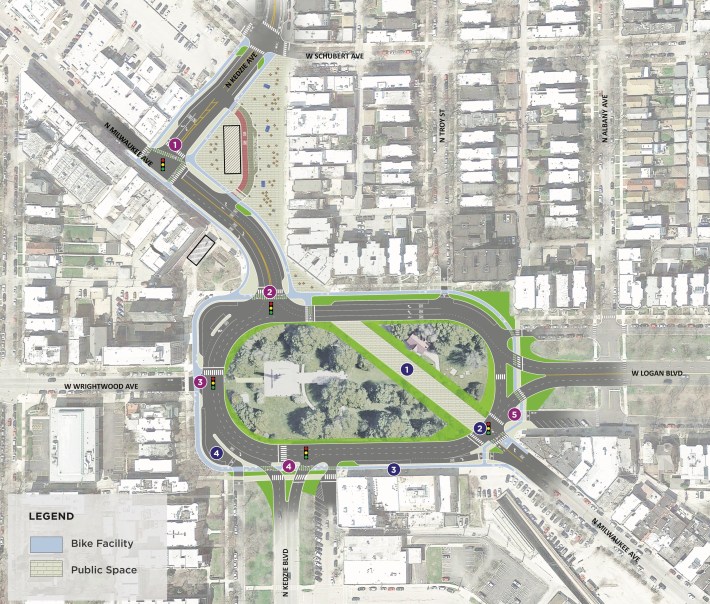
The third option, "Two Way, Trip Match," would convert the streets on the west and south sides of the circle to two-way traffic to provide more direct routes for the most common traffic movement. Milwaukee and Kedzie would keep their current locations, but the most of the roadway on the north and east side of the circle would be converted to park space.
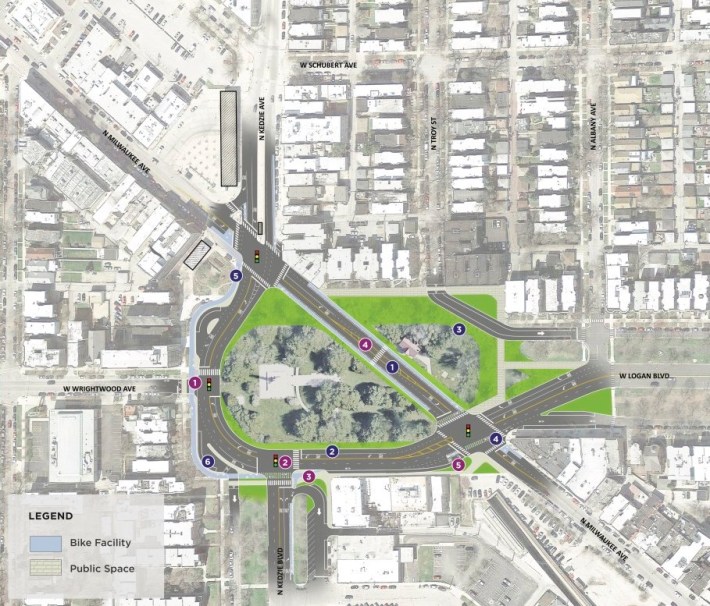
Based on feedback from attendees a previous community meetings, as well as the local aldermen, community groups, and other stakeholders, CDOT ultimately settled on concept four, "Two Way, The Bend" as the best option. This "bends" traffic on Milwaukee to the north and east sides of the circle, unifying the existing green space, and also includes the Kedzie reroute and plaza. Traffic on the south and west sides of the plaza would become two-way.
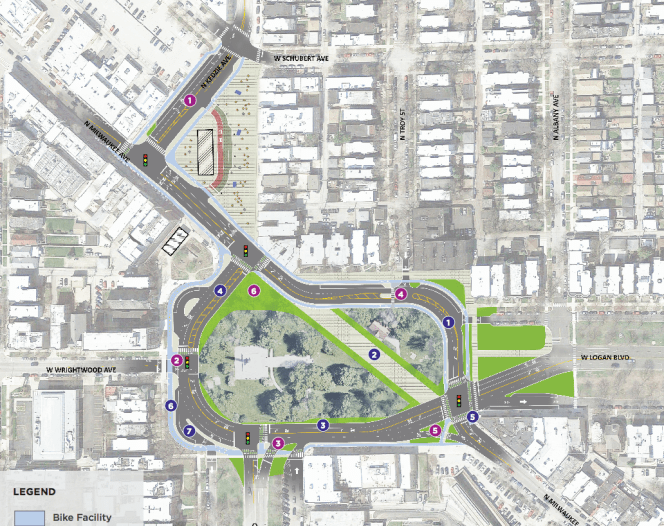
While Traffic Oval and Two Way, The Bends have things in common, CDOT's detailed analysis determined the fourth scenario would do a better job of improving pedestrian access; would allow flexible use of public streets, including closures for festivals and other special events; and would have the greatest impact on traffic safety. While concept two would only include two crosswalks, for example, concept four would feature eight pedestrian crossings. CDOT also argued at the meeting, using a traffic simulation video, that the Two Way, The Bend layout would be less confusing for drivers.
As for the rest of the Milwaukee corridor, CDOT is recommending the less bold of two options. The department initially floated the idea of building fully separated bike lanes on this high-bike-traffic street. But since this would have required eliminating 46 percent of the on-street parking spaces, it would have been politically difficult.
Instead, CDOT is planning to stripe dashed bike lanes on the relatively narrow roadway, similar to the current layout of Milwaukee in Wicker Park. On the plus side, the corridor will get new sidewalk bump-outs to shorten pedestrian crossing distance and provide space for sidewalk cafe seating.
CDOT's lead engineer for the project, Nate Roseberry, indicated that, barring a major uprising against the project, the department should be moving forward with construction of concept four in the near future.
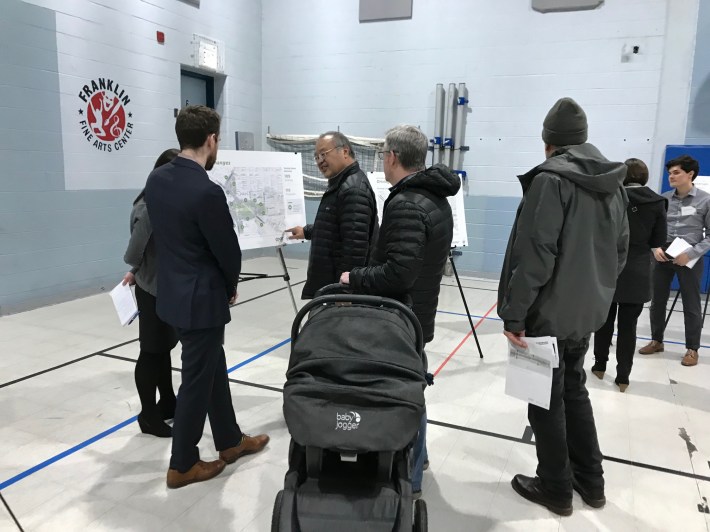
Such an insurrection seems unlikely at this point. At the meeting, which was attended by some 150 people, I heard a few grumbles from residents who felt that the free-flowing traffic shown in CDOT's traffic simulation was unrealistic. But most people I spoke with supported the designs CDOT chose, citing the improvements to safety and access, and the creation of new public space and the ability to use the streets more flexibly. One resident said she was particularly excited about the possibility of relocating the Logan Square farmers market onto the pedestrianized section of Milwaukee.
Representatives from Chicago United for Equity spoke with attendees as they entered the space, requesting that they fill out a questionnaire asking for their opinions about the potential burdens and benefits for of the project. Along with the Logan Square Neighborhood Association, the group held meetings earlier this year as part of a Racial Equity Impact Assessment of the project. Their goal is to prevent longtime residents from being displaced by increased housing costs in the wake of this neighborhood improvement, which will make the area a more desirable place to live and raise property values.
A rep from CUE told me they want to see the city be proactive about preserving affordability with strategies such as turning the Emmett Street parking lot, next to the main Blue Line entrance, into an all-affordable housing development. She said they'd like to see CDOT voice support for preserving affordability, in order to help get other relevant city agencies on board with the idea.
When I asked Roseberry about the possibility of CDOT endorsing the idea of creating an affordability strategy for the circle project, he simply referred me to the Department of Planning and Development to get a comment, implying that CDOT was solely concerned with the transportation aspects of the project.
But as we've seen from CDOT projects like the Bloomingdale Trail, which has been associated with a major spike in housing prices along its corridor in Logan Square and Humboldt Park, transportation projects can't just be viewed in silos -- their impact on affordability must also be considered.
![]()
Did you appreciate this post? Consider making a donation through our PublicGood site.





